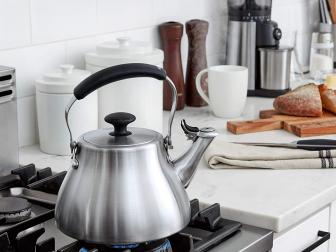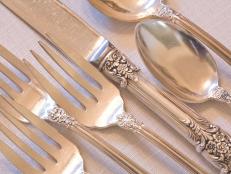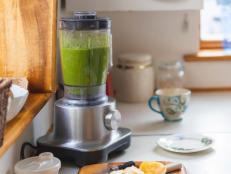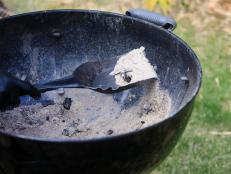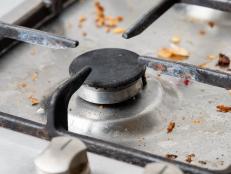How to Clean an Electric Kettle
A step-by-step guide to keep your kettle in prime condition.

Richard Drury/Getty Images
By Layla Khoury-Hanold for Food Network Kitchen
Layla Khoury-Hanold is a contributor at Food Network.
If you have an electric kettle, you may have wondered about the best ways to clean it—and how often to do so. To learn how to keep an electric kettle in peak condition, we consulted Karen Diep, a product expert at Breville, a manufacturer of kitchen and cooking appliances.
What Is an Electric Kettle?
An electric kettle is an appliance used for boiling water as an alternative to the stovetop. When an electric kettle is plugged in and turned on, its heating element boils the water. Once the water boils, the heat source deactivates to prevent the water from continuing to boil and, eventually, to evaporate.
There are a variety of electric kettles on the market. “Most models use an upright design that allows the heating element at the bottom of the jug to be fully covered, even with just 1 cup of water,” Diep says. “Some models will include a sensor that detects a low water level, to prevent dry boiling-which can damage the kettle over time. Some kettles will also include options for various temperatures that are ideal for specific types of tea.”
Why Is My Electric Kettle Scaly?
Electric kettles get scaly over time due to limescale buildup caused by the natural mineral content in water. “Whether or not you are pulling your water from the tap or a water bottle, it will have some level of minerality to it, and that is completely natural." This is true even if you use filtered water.
If you’re curious about the mineral content in your water and how hard your water is, Diep advises purchasing a water test online or from a home improvement store.
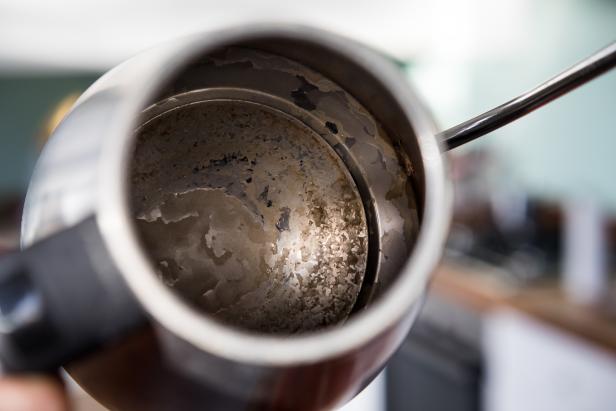
Photographer, Basak Gurbuz Derman/Getty Images
How Often Should You Clean an Electric Kettle?
An electric kettle can be rinsed and descaled as often as needed. The frequency or amount of scaling you need to do depends on how hard or heavy your water is, Diep says. “If you have especially hard water and find your kettle scaling fast, you can use a water filter to make your water less heavy."
Don’t let scaling build up, as it makes it harder to remove and can require several rounds of descaling to remove. “Descaling the kettle is simple and can be done whenever you see visible scaling along the inside,” Diep says. “This varies depending on how hard your water is. For some, you may need to descale your water every three months, others may take longer to build up–or quicker, depending on how much scaling accumulates on their appliance.”
3 Ways to Clean Your Electric Kettle, Step-by-Step
How To Clean the Outside of Your Electric Kettle
Step 1: Wipe it clean. Use a non-abrasive cleaner and a pad or towel to wipe down the top and sides of your kettle.
Step 2: Keep it dry. Avoid getting the base of the kettle wet to prevent electrical shock or damage to the kettle.
Step 3: Repeat. Repeat whenever you notice the kettle needs a touch-up.
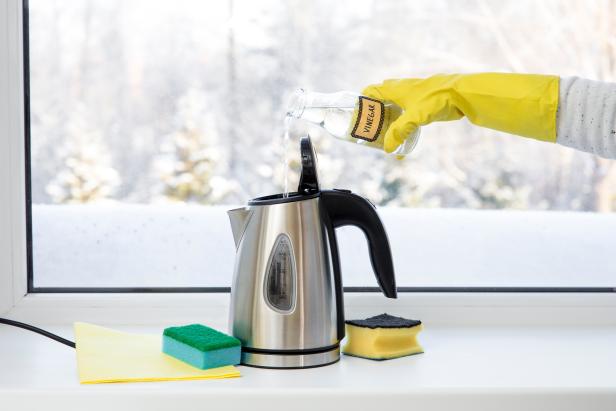
Helin Loik-Tomson/Getty Images
How to Clean the Inside of Your Electric Kettle
Step 1: Prepare a cleaning solution. Place 1 to 2 teaspoons of baking soda inside the kettle and add enough water to make a paste.
Step 2: Scrub. Use a soft brush (like a bottle brush) to scrub the interior of the kettle and remove any deposits or debris.
Step 3: Add vinegar. Add vinegar to the kettle until the baking soda starts to bubble, and then rinse out with water.
If your kettle only needs a light refresh, you can exclusively use baking soda to remove debris from the interior, Diep says. This is also a worthwhile preliminary step before you descale the kettle.

Ashton Call/Getty Images
How to Descale Your Electric Kettle
With descaling solution: One way to descale your electric kettle is to purchase a descaling solution at a home improvement store or wherever electric kettles are sold. Typically made with citric acid, descaling solutions come in either powder or liquid form and are easily mixed with water. This approach tends to be less odorous than using distilled vinegar to clean your kettle (more on that below). Diep suggests following the instructions indicated on the packaging of the descaling solution.
With vinegar: If you do not have descaling solution or prefer to use a common household cleaner, you can also descale your kettle using distilled white vinegar.
Step 1: Rinse. Rinse out your kettle to remove any floating debris.
Step 2: Mix the solution. Fill your kettle with equal parts distilled white vinegar and filtered water up to the “MAX” line, or up to wherever the visible scaling ends on the inside of your kettle.You can also add a bit of lemon juice to help mask the vinegary smell. Lemon juice on its own isn’t a strong enough acid to remove the scaling on kettles and other appliances.
Step 3: Turn on the kettle. Turn on the kettle and allow the solution to reach a full boil.
Step 4: Scrub the kettle. Pour out the boiled vinegar solution and rinse with water. If there is stubborn grime that didn’t come off, allow the kettle to cool and use a soft scrubbing brush to remove. If you don’t see visible grime, skip this step.
Step 5: Refill and boil. Fill the kettle again, this time with plain filtered water, and boil.
Step 6: Rinse. Pour out the boiled filtered water and rinse out the kettle to remove the vinegary aroma.
Step 7: Repeat as needed. If there's still visible scaling inside of the kettle, repeat the steps above.
When in doubt, Diep suggests following the handling and care suggestions in the manufacturer’s user manual.
5 Best Stovetop and Electric Kettles, Tested by Food Network Kitchen
Whether you're in the market for a stovetop tea kettle or a precise electric model, these are the best kettles you can buy.
Related Links:
























